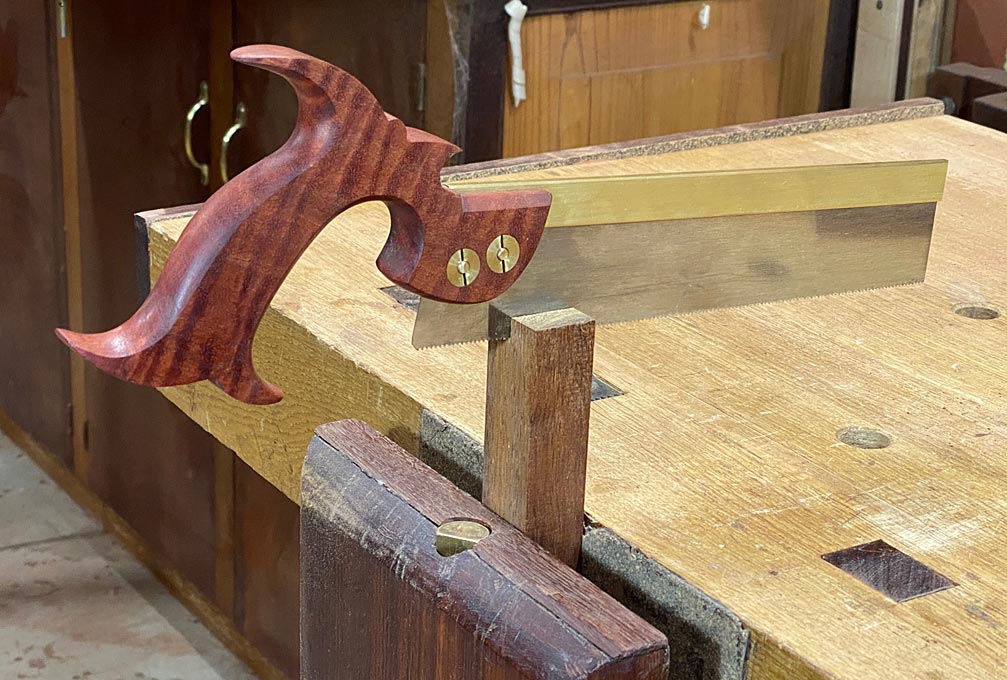The teeth are now formed and relatively sharp, the next step is to apply some set, this is where one tooth is bent to one side of the blade and the next to the opposite side of the blade. This is repeated down the entire blade. The alternative bending of the teeth effectively increases the width of the blade and when cutting creates a slot or kerf that is wider than the blade. The kerf needs to be wider than the blade to stop the blade from binding and getting trapped in the wood.
How much set should be applied to the teeth? well, in theory the bigger the teeth the more set that is required as the cut will be rougher and the walls of the kerf won't be as even which might trap the blade. If you saw hardwood you don't need as much set as you do for softwoods which are generally more resinous and 'stickier' wood. If you cut Dovetails with the saw you want a fine kerf to help with accuracy.
Just a note, the only real difference between a Dovetail saw and a tennon saw is
1. The death of cut, that is from the teeth to the back is narrower for a Dovetail saw
2. The saw plate is often just a smigin narrower on a Dovetail saw.
Neither of these IMO really make the saws different and you can use a well tuned tennon saw to cut Divetails.
What to do in practice? well I add as little set as I can get away with on the saw, I know I can always add a little more set if I need it, but I can't reduce the set once I've done it very effectively (apart from sharpening the teeth which reduces the amount of set due to the teeth being bent. The tips of the teeth being bent the furthest away from the plate, sharpening reduces the tip height and therefore the amount they are bent away from the plate.)
Initially you want to add a few thousands of an inch of total set, that's the width of the kerf compared to the blade.
The Eclipse saw set has a hammer (moving bit) and an anvil that can be rotated to different positions. All Ecliose saw sets that I have seen (fine and course) go up to 12. I normally leave my Eclipse set at either 10 or 11 for a backed saw. The difference between the two is so small it's not worth worrying about.
With the saw in the vice place the saw set on the blade and starting at the heel (handle end) on the first tooth set the saw set down on the teeth with the hammer positioned exactly on the tooth. Squeeze the handle and keep looking at the tooth. You will see the tooth move, now continue sneezing, and you will start to see the tooth slightly deform, remember the pressure needed to move the tooth and the higher pressure needed to deform the tooth (squash it a little). For all subsequent teeth you want to apply a pressure a little more than needed to move the tooth and not enough to deform the tooth. You can normally feel a difference between moving the tooth and when you start to deform it. Sounds complex, but once you've done it, you will know what you are 'feeling for'
Move the saw set missing the next tooth and set the third tooth. Repeat for every other tooth....1,3,5,7,9...
Turn the saw around and repeat for the 2,4,6,8,10....tooth, in other words the teeth that you haven't set. You will now set the teeth.
View attachment 47659
You can see how the hammer is positioned on the tooth and also to the left the teeth set with one tooth bent to one side and the next the opposite way (this was done for the photo)
The first few teeth are the most difficult to set, as the Eclipse guide is not resting fully on all of the teeth and needs to balanced. Be careful not to let the Ecliose drop down the hammer needs to be positioned so that it pushes just under the tip of the tooth.





